Indentical isolated conduction sphers 1 and 2 have equal charges and are separated by a distance that is large compared with their diameters (Fig.a). The electrostatic force acting on spkhere 2 due to sphere 1 is F. Suppose now that a third identical sphere 3, having an insulation handle and initially neutral, is touched first to sphere 1 (Fig. b), then to sphere 2 (Fig. c), and dinally removed (Fig. d). The electrostatic force that now acts on sphere 2 has magnitude F'. What is the ?
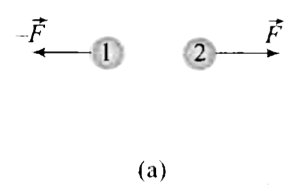
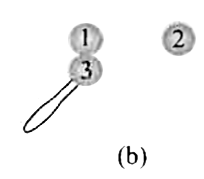
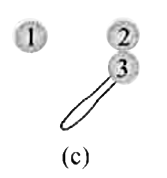
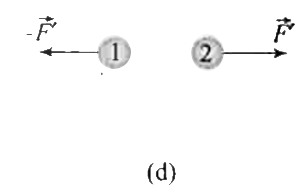
The correct Answer is:C
To solve the problem, we will analyze the situation step by step:
Step 1: Initial Setup
We have two identical isolated conducting spheres, Sphere 1 and Sphere 2, each with an equal charge q. The electrostatic force F acting on Sphere 2 due to Sphere 1 is given by Coulomb's law:
F=kq⋅qr2=kq2r2
where k is Coulomb's constant and r is the distance between the centers of the two spheres.
Hint: Remember that the force between two point charges is given by Coulomb's law.
Step 2: Touching Sphere 3 to Sphere 1
Sphere 3 is initially neutral and is touched to Sphere 1. When Sphere 3 touches Sphere 1, charge will redistribute. The total charge before touching is q+0=q. After touching, the charge will be equally distributed between Sphere 1 and Sphere 3:
Charge on Sphere 1=q+02=q2
Charge on Sphere 3=q+02=q2
Hint: When two conductors touch, charge redistributes equally because they are identical.
Step 3: Touching Sphere 3 to Sphere 2
Next, Sphere 3 (now with charge q2) is touched to Sphere 2, which has charge q. The total charge when they touch is:
Total charge=q+q2=3q2
After touching, this charge will also redistribute equally between Sphere 2 and Sphere 3:
Charge on Sphere 2=Charge on Sphere 3=3q/22=3q4
Hint: Again, charge redistributes equally when two identical conductors touch.
Step 4: Calculating the New Force F′
Now, we need to calculate the new force F′ acting on Sphere 2 due to Sphere 1. Sphere 1 now has a charge q2 and Sphere 2 has a charge 3q4. The force F′ is given by:
F′=k(q2)(3q4)r2=k3q28r2
Step 5: Finding the Ratio F′F
Now we can find the ratio of the new force F′ to the original force F:
F′F=k3q28r2kq2r2=38
Final Answer
Thus, the ratio F′F is:
F′F=38
---
We have two identical isolated conducting spheres, Sphere 1 and Sphere 2, each with an equal charge q. The electrostatic force F acting on Sphere 2 due to Sphere 1 is given by Coulomb's law:
Sphere 3 is initially neutral and is touched to Sphere 1. When Sphere 3 touches Sphere 1, charge will redistribute. The total charge before touching is q+0=q. After touching, the charge will be equally distributed between Sphere 1 and Sphere 3:
Charge on Sphere 3=q+02=q2
Next, Sphere 3 (now with charge q2) is touched to Sphere 2, which has charge q. The total charge when they touch is:
Now, we need to calculate the new force F′ acting on Sphere 2 due to Sphere 1. Sphere 1 now has a charge q2 and Sphere 2 has a charge 3q4. The force F′ is given by:
Now we can find the ratio of the new force F′ to the original force F:
Thus, the ratio F′F is:
Topper's Solved these Questions
- COULOMB LAW AND ELECTRIC FIELDBook:CENGAGE PHYSICS ENGLISHChapter:COULOMB LAW AND ELECTRIC FIELDExercise:Subjective
Explore 32 Videos
- COULOMB LAW AND ELECTRIC FIELDBook:CENGAGE PHYSICS ENGLISHChapter:COULOMB LAW AND ELECTRIC FIELDExercise:Single Correct
Explore 47 Videos
- COULOMB LAW AND ELECTRIC FIELDBook:CENGAGE PHYSICS ENGLISHChapter:COULOMB LAW AND ELECTRIC FIELDExercise:Exercises
Explore 58 Videos
- CENGAGE PHYSICS DPPBook:CENGAGE PHYSICS ENGLISHChapter:CENGAGE PHYSICS DPPExercise:subjective type
Explore 51 Videos
- ELECTRIC CURRENT & CIRCUITSBook:CENGAGE PHYSICS ENGLISHChapter:ELECTRIC CURRENT & CIRCUITSExercise:Kirchhoff s law and simple circuits
Explore 15 Videos
Similar Questions
Two identical conducting spheres 1 and 2 carry equal amounts of charge and are ficed apart at a certain distance larger than their diameters. The spheres repel each other with an electrical force of 88mN. A thired identical sphere 3, having an insulating handle and initially uncharged, is touched first to sphere 1 and then to sphere 2 and finally removed. Find the force between spheres 1 and 2 as shown if Figure.
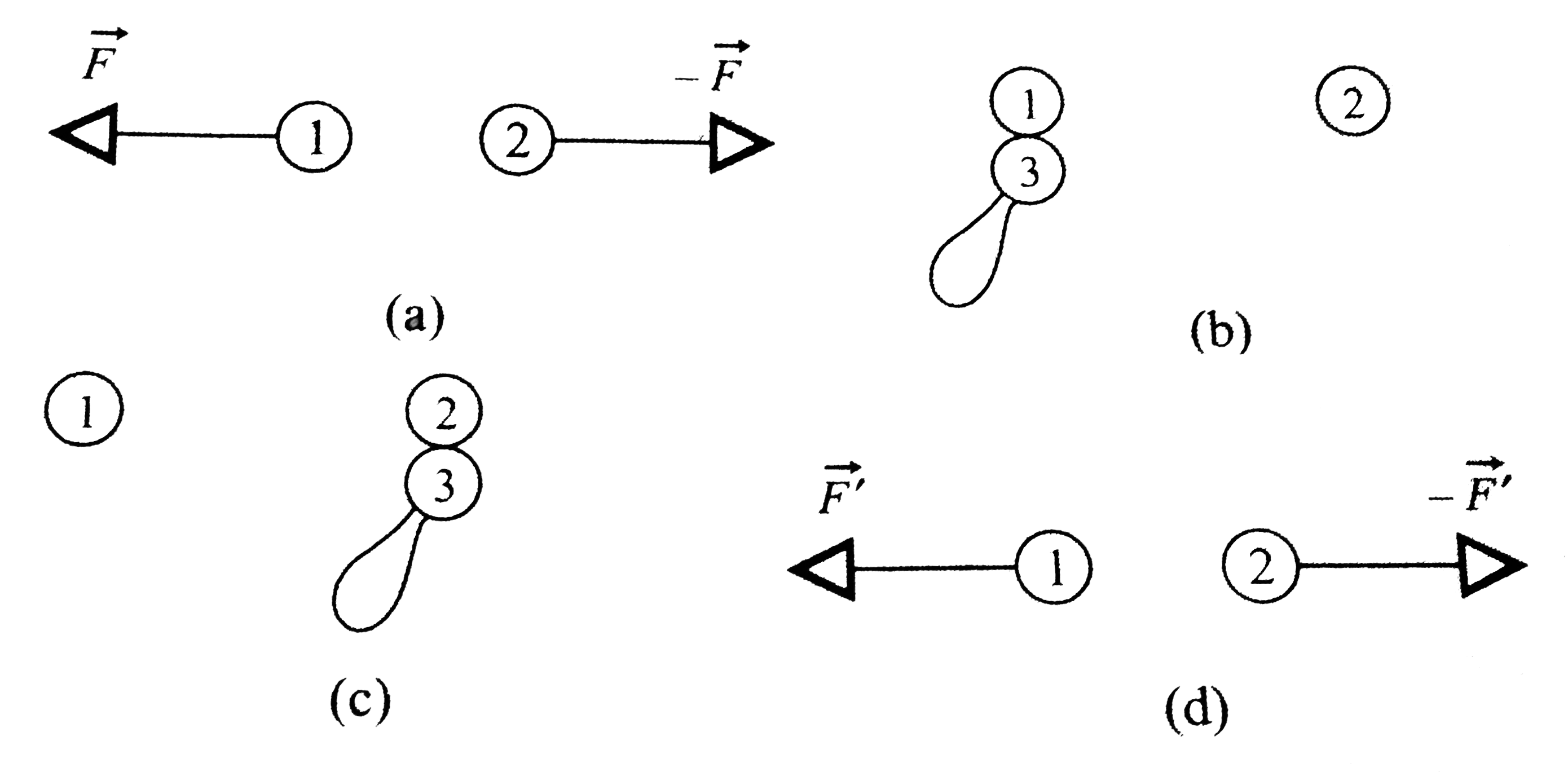 ,
,
View SolutionTwo identical small conducting spheres having unequal positive charges q1 and q2 are separated by a distance r. If they are now made to touch each other and then separated again to the same distance, the electrostatic force between them in this case will be
View Solution
Knowledge Check
Two insulated charged metallic spheres P and Q have their centres separated by a distance of 60 cm. The radii of P and Q are negligible compared to the distance of separation. The mutual force of electrostatic repulsion if the charge on each is 3.2×10−7C is
A5.2×10−4NB2.56×10−3NC1.5×10−3ND3.5×10−4NThe electrostatic attracting froce on a small sphere of charge 0.2μC due to another small sphere of charge −0.4μC in air is 0.4N. The distance between the two spheres is
A43.2×10−6mB42.4×10−3mC18.1×10−3mD19.2×10−6m
Two identical small conducting spheres having unequal positive charges q1 and q2 are separated by a distance r. If they are now made to touch each other and then separated again to the same distance, the electrostatic force between them in this case will be
View SolutionAn isolated conduction sphere sphere whose radius R=1 m has a charge q=19nC. The energy density at the surfasce of the sphere is
View SolutionTwo identical conducting spheres A and B, carry equal charge. They are separated by a distance much larger than their diameters, and the force between them is F. A third identical conducting spheres, C,is uncharged. Sphere C is first touched to A, then to B, and then removed. As a result, the force between A and B would be equal to :
View SolutionTwo conducting spheres of radii 3 cm and 1 m are separated by a distance of 10 cm in free space. If the spheres are charged to same potential of 10 V each, then the force of repulsion between them is
View SolutionTwo identical conducting spheres are charged by induction and then separated by a large distance, sphere 1 has charge +Q and sphere 2 has charge -Q. A third sphere is initially uncharged. If sphere 3 is touched to sphere 1 and separated and then touched to sphere 2 and separated what is the final charge on each of the three spheres?
View SolutionTwo conducting spheres of radius R and 3R carry charges Q and −2Q. Between these spheres a neutral conducting sphere of radius 2R is connected. The separation between the sphere is considerably large Charge flows through conducting wire due to potential difference.

The final charge on initially neutral conducting sphere is :
View Solution